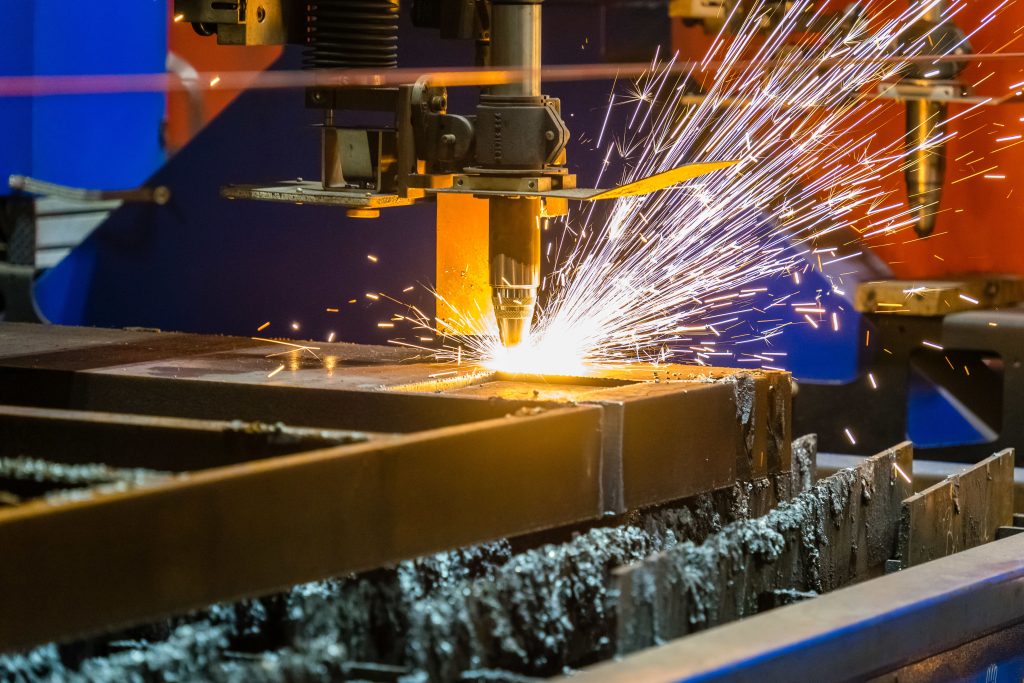Strona główna » Services » Plasma cutting
Plasma cutting
Plasma cutting
Plasma cutting involves melting and ejecting metal from the cutting gap through a highly concentrated plasma electric arc. This arc is created between the non-consumable electrode and the material being cut and is a strongly ionized plasma gas with high kinetic energy. The gas moves from the plasma nozzle towards the material being cut, and the temperature of the plasma stream reaches 30,000K. Shielding gas prevents air from entering the cutting area and cools the cutting gap, reducing thermal deformation of the material. The temperature and speed of the plasma stream depend on, among others, on the current intensity, the shape and diameter of the nozzle, the type of plasma gas and its pressure.
The plasma arc cutting method allows the processing of all electrically conductive construction materials. It is also possible to cut non-metallic materials thanks to the use of a plasma torch with a non-ferrous arc.

Ferrotech offers:
- Plasma cutting of carbon steel up to 25mm thick,
- Plasma cutting of stainless steel up to 20mm thick,
- Plasma cutting of aluminum up to 20mm thick,
- Cutting other materials on request.
Plasma can be used to cut sheets, sections and meshes, but also pipes and bars of considerable thickness. Another great advantage of this method is the fact that plasma-cut surfaces do not have to be cleaned first, so it is possible to process rusty, dirty and painted or varnish-covered surfaces. It is worth adding that we have a CNC plasma plotter with working area dimensions of 1550mm x 3050mm.
What is plasma?
Plasma, called the fourth state of matter, is ionized matter, resembling a gas in its structure. However, what distinguishes it from gas is the higher ionization of particles (there is a predominance of positively charged particles – cations or negatively – free electrons).
Plasma conducts electricity and its resistance decreases as the temperature increases. When the intensity of the flowing current reaches a sufficiently high value, the plasma emits energy in the form of light and heat.
Methods of cutting sheet metal and metal
Plasma torches offer wide possibilities for cutting sheet metal and metal.
- Beveling: in this case, the torch is tilted at an appropriate angle so as to obtain a sloping edge after cutting;
- Cutting on a CNC plotter: cutting any shapes with an accuracy of up to 0.2 mm;
- Gouging: thanks to the use of special consumable parts, it is possible to create regular grooves in the processed material – this way you can remove, for example, a defective weld or separate previously welded elements;
As you can see, plasma torches are useful in various specialized works. Cutting sheet metal and metal using plasma tools guarantees quick execution of works, but also high accuracy of activities. As a side note, it should be added that precision and repeatability are the two greatest advantages of all specialized numerically controlled machines. CNC devices are also characterized by a high level of intuitive interface, which significantly facilitates the work of machine operators. It should be emphasized, however, that despite numerous advantages, numerically controlled devices are not fully autonomous, and their operation requires specific qualifications and, above all, a specific type of imagination and knowledge in the field of geometry and programming.So if you are looking for specialists in scope of cutting sheet metal and metal, please contact us.
